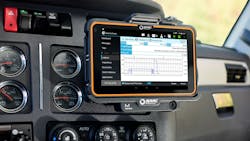How using a smart tablet as an ELD improves driver efficiency and safety
That screen in front of the driver? Sure, it is required to comply with hours-of-service regulations. But it can do so much more than log hours.
“That’s what they need to make sure the drivers are compliant to the hours of service; in-cab technology is first and foremost a requirement for regulation,” Melanie Simard, VP of safety, compliance & technical support at Isaac Instruments, told FleetOwner. “But then it expands to so much other stuff that you can do with an in-cab solution.”
Using a tablet as an ELD
FMCSA requires most motor carriers and drivers to use electronic logging devices. The devices were implemented to ensure drivers abide by hours-of-service regulations in real-time (as opposed to using paper logs), thereby reducing fatigued driving and improving commercial vehicle safety.
See also: FMCSA revoked two ELDs—one now reinstated
Regulations limit how widely ELD use can vary. Generally, ELDs have to sit in the same position, visible to the driver in a sitting position, without obstructing the windshield. The device also needs to connect to the vehicle’s engine control module.
However, the type of device used can be drastically different between fleets.
“Most devices you’ll see in a truck nowadays are pretty much at the same location,” Simard said. “It’s just a matter of [the type of device]. Is it a trucking-grade tablet like we have? Is it just a consumer-grade tablet? Is the driver using a cell phone?”
Many FMCSA-registered ELDs are designed to do only that one thing: log hours. However, the position of an ELD is prime real estate for portable technology to assist drivers. Choosing smart equipment with wireless communications capabilities, like a tablet, not only allows for hours-of-service compliance but also all the functions of a dedicated computer.
Reduce distractions
The more that an in-cab device can do, the more opportunities it brings for driver distraction.
“If you give them [drivers] a cell phone .... if it’s on the dash right there, they might open Facebook, they might click on a notification. It’s human behavior,” Simard said. “That’s primarily why we have built a tablet that’s proprietary. We want to make sure those drivers are not distracted on the road.”
Some tablets, like Isaac’s, include dedicated safety features to reduce driver distractions. The device can lock out all unnecessary functions when the vehicle is in motion.
“Our tablet, when the drivers pulls into gear [and] starts moving the truck, everything locks,” Simard said. “There’s no way you can click on it, open Facebook, YouTube, nothing.”
When they engage the engine, drivers can only see: the map, their Isaac Coach, how many hours they have remaining that day, and pop-up notifications. The notifications inform the driver of important updates such as if they are about to run out of hours or had just performed a hard brake.
Going beyond logging hours
Modern technologies can store immensely powerful computers in small packages—with the right equipment, that hour-logging device in front of the driver can be capable of much more.
A gateway is key
To unlock the potential of an in-cab device, it needs to communicate with a fleet’s transportation management system.
“Yes, we have the in-cab tablet that the driver uses. That’s what we see, that’s what they use,” Simard said. “But what’s gathering all that data is the gateway.”
Fleets using a gateway for their vehicle generally install it inside the dash, out of view. It receives operational data through the vehicle’s controller area network and uses cellular communication to transmit data to a fleet’s servers—and thus its TMS.
See also: Fleets Explained: What is a TMS?
“That gateway is also recording everything a driver does on the tablet: every screen tap, every scanning picture, doing their logbook,” Simard said. “Everything that’s done on the tablet is also sent to the same gateway and that gateway communicates to the server.”
TMS communication is what allows the in-cab device to do much more than log hours. With this, in-cab technology can help drivers navigate their workflows and communicate with dispatchers.
Drivers can use the same tablet to track picking up their trailers, running inspections, going to the right client, and more. Coordinating these tasks and their data through a TMS also means that everybody in the fleet has access to the same information.
A device for inspections
Pre- and post-trip inspections are an essential component of commercial vehicle safety—and are mandated by FMCSA.
See also: It’s time to reinforce inspection basics
“[If] we have newer drivers, we want to make sure that they’re following, step by step, every single thing they need to inspect around the truck," Simard said.
Inspection workflows are a perfect opportunity for portable devices to replace physical paperwork.
Companies such as Isaac can provide step-by-step instructions through their devices to guide drivers through inspections and reports. If something on the vehicle looks wrong, users can take and submit pictures with the device’s integrated camera.
“Having this smart inspection DVIR feature gives the driver the opportunity to walk around the truck with their tablet and make sure they inspect every point,” Simard said.
Fleets can also customize their inspection points according to equipment type.
“A tanker fleet will have a [different] inspection point than a flatbed driver than a dry box driver,” Simard said. “Everything’s customizable; you know your flatbed driver will look at his load securement in another way than the tanker driver.”
About the Author
Jeremy Wolfe
Editor
Editor Jeremy Wolfe joined the FleetOwner team in February 2024. He graduated from the University of Wisconsin-Stevens Point with majors in English and Philosophy. He previously served as Editor for Endeavor Business Media's Water Group publications.


